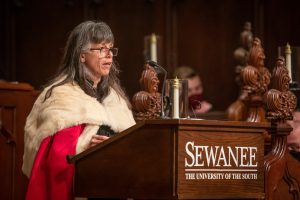My friend JD Blackrose has a new book coming out — Demon Kissed, a novel I was happy to blurb. Today she drops some writing wisdom on us. Read on!
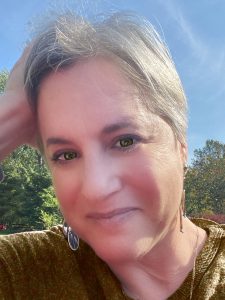 You won’t get your best ideas sitting at your desk. You’ll get them in the shower. Or, when you’re driving your car, or taking a walk on a snowy day.
You won’t get your best ideas sitting at your desk. You’ll get them in the shower. Or, when you’re driving your car, or taking a walk on a snowy day.
Unfortunately, the only things these three scenarios have in common is that you usually can’t write anything down. I’m willing to guess that authors lose more ideas to a lack of pen and paper than to anything else.
In an article on the website for the meditation app, Headspace, author Christine Yu reports that her cousin once gave her a waterproof notepad and pencil so when she got her best idea in the shower, she had a place to write it down. (I didn’t know such a thing existed, but it does. Google “Aquanotes.”)
Or do what I do and carry your phone with you. Type a few quick words into the Notes section of your phone at a red light. If you are a sophisticate, leave yourself a voice memo. In the shower or while chopping veggies, when you can’t just stop mid-suds or slice, yell to your partner, “Remind me about the pig with the swizzle stick,” or ask Siri to take a memo. Just saying it out loud should be enough to get you through a quick wash or salad.
It’s all good, and it is all valuable, because you’ll need those notes of inspiration later. How many times have you been raring to go, ready to write, only to sit in front of your computer and find your ideas have dried up?
 It’s happened to all of us. It happened to me writing my new book, Demon Kissed, and the next two in The Summoner’s Mark trilogy, coming from Bell Bridge Books.
It’s happened to all of us. It happened to me writing my new book, Demon Kissed, and the next two in The Summoner’s Mark trilogy, coming from Bell Bridge Books.
Luckily, I had notes for inspiration, and I used them to get a handle on the main character and her voice. If I hadn’t had those stolen thumb-typed crib sheets, I wouldn’t have gotten a foothold on the story at all, or maybe I would have, but it would have been much later and my chance to pitch the books might have passed me by.
Writer A.A. Milne is often quoted as saying, “Don’t underestimate the value of doing nothing.” This is accurate, but the full quote is, “Don’t underestimate the value of doing nothing, of just going along, listening to all the things you cannot hear, and not bothering.”
Very Winnie-the-Pooh.
As writers, we talk a lot about “butt-in-chair” practice. Get a certain number of words each day! Set aside one hour every single day! Write a story start to finish.
It’s all good advice, and yet, nonsense.
According to Yu’s article, problem solving through insight involves the right temporal lobe of the brain, while problem solving via a more active, analytical approach involves the frontal lobe. We literally are using our minds differently, and being in the shower, or exercising, or being in woods puts us in a state of rest and relaxation, ready to receive inspiration.
In other words, we need both. I do a lot of yoga and the title of this piece comes from an online yoga instructor who said, “Down time is not wasted time.” He’s absolutely correct, and though he was talking about yoga, it applies to our writing practice too. Spinning our wheels in front of the computer makes us cranky and defeated. It is the opposite of what we are trying to achieve, and when we do create words under those conditions, they are often stilted.
While I believe in creating a writing habit, something I’m going to write a book about soon, I also believe that writing time is not necessarily all about fingers on keyboard or pen in hand. You must pay attention to the other part of your brain and give it the space it needs to work.
Malcolm Gladwell, in his book, Blink: The Power of Thinking Without Thinking, talks about the “Four Horsemen: defensiveness, stonewalling, criticism, and contempt.” If this sounds like your inner voice, it is time to take a break and go for a stroll. Take notes or dictate into your phone, or dare to do nothing and not bother, like A.A. Milne. Come back to your writing later. The words might be there then.
*****
About JD Blackrose
JD Blackrose is the author of The Summoner’s Mark series from Bell Bridge Books, and The Soul Wars, The Devil’s Been Busy, and the Zombie Cosmetologist novellas from Falstaff Books, as well as numerous short stories, including “Welcome, Death” in the Jewish Book of Horror.
Demon Kissed is out February 28th.
Follow JD Blackrose on Twitter and Facebook
Visit the author’s website. Read an excerpt of Demon Kissed.
Purchase: Indiebound | B&N | Amazon | Kobo









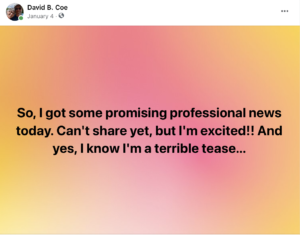 Nearly two months ago, early in the new year, I posted on social media that I had some exciting professional news I couldn’t share quite yet. I was thrilled, and wanted to let people know. But I also didn’t want to say anything before all the details had been settled. So I posted my little teaser, forgetting the one immutable rule of the publishing business: Things always happen slower than one thinks they will.
Nearly two months ago, early in the new year, I posted on social media that I had some exciting professional news I couldn’t share quite yet. I was thrilled, and wanted to let people know. But I also didn’t want to say anything before all the details had been settled. So I posted my little teaser, forgetting the one immutable rule of the publishing business: Things always happen slower than one thinks they will.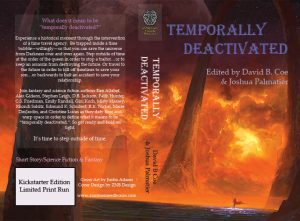 Since writing it, though, I have become sort of fixated on the idea. I am editing my fourth anthology, and already looking at the possibility of editing another. My freelance editing business is attracting a steady stream of clients — I’m booked through the spring and have had inquiries for slots later in the year.
Since writing it, though, I have become sort of fixated on the idea. I am editing my fourth anthology, and already looking at the possibility of editing another. My freelance editing business is attracting a steady stream of clients — I’m booked through the spring and have had inquiries for slots later in the year.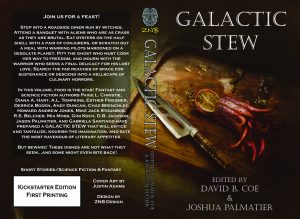 I am not an acquiring editor. I do decide, along with my co-editor, whose stories will be in the anthologies I edit, so I suppose in that way I am determining the fate of submissions and, in a sense, “buying” manuscripts. But, for now at least, I don’t make decisions about the fate of novels, and so I don’t have to go toe-to-toe with agents. Good thing. They scare me. (Looking at you, Lucienne Diver.)
I am not an acquiring editor. I do decide, along with my co-editor, whose stories will be in the anthologies I edit, so I suppose in that way I am determining the fate of submissions and, in a sense, “buying” manuscripts. But, for now at least, I don’t make decisions about the fate of novels, and so I don’t have to go toe-to-toe with agents. Good thing. They scare me. (Looking at you, Lucienne Diver.)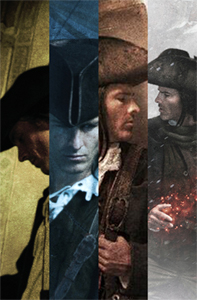 I am not the most talented writer I know. Not by a long shot. I am good. I believe that. My character work is strong. My world building is imaginative. My prose is clean and tight and it flows nicely. I write convincing, effective dialogue and I have a fine eye for detail. My plotting and pacing, which were once just okay, have gotten stronger over the years. I think writing the Thieftaker books — being forced to blend my fictional plots with real historical events — forced me to improve, and that improvement has shown up in the narratives of the Islevale and Radiants books.
I am not the most talented writer I know. Not by a long shot. I am good. I believe that. My character work is strong. My world building is imaginative. My prose is clean and tight and it flows nicely. I write convincing, effective dialogue and I have a fine eye for detail. My plotting and pacing, which were once just okay, have gotten stronger over the years. I think writing the Thieftaker books — being forced to blend my fictional plots with real historical events — forced me to improve, and that improvement has shown up in the narratives of the Islevale and Radiants books.
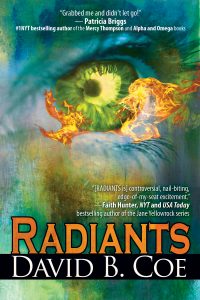 8. You read
8. You read 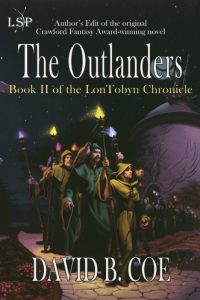 The Outlanders, my second book, may well be the most significant of all the books I’ve published. I knew I had it in me to write one book. But when I finished The Outlanders, and realized it was even better than CofA, I knew I was more than a guy who could write a novel. I was an author. And when Children of Amarid and The Outlanders together were given the Crawford Fantasy Award by the IAFA (International Association for the Fantastic in the Arts), for best fantasy by a new writer, I knew I would have a professional career beyond that first series.
The Outlanders, my second book, may well be the most significant of all the books I’ve published. I knew I had it in me to write one book. But when I finished The Outlanders, and realized it was even better than CofA, I knew I was more than a guy who could write a novel. I was an author. And when Children of Amarid and The Outlanders together were given the Crawford Fantasy Award by the IAFA (International Association for the Fantastic in the Arts), for best fantasy by a new writer, I knew I would have a professional career beyond that first series.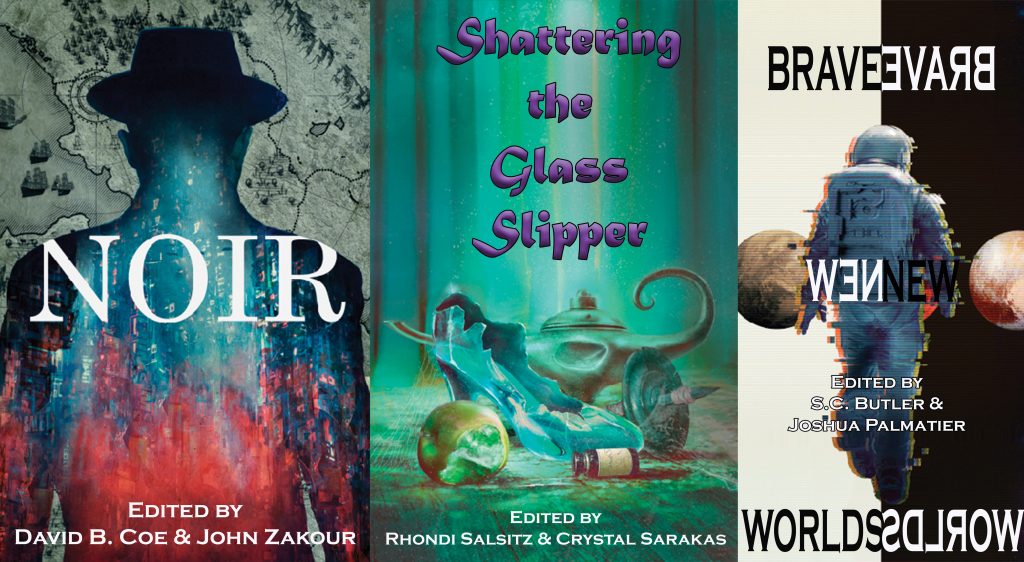 As many of you know, I am once again co-editing an anthology for
As many of you know, I am once again co-editing an anthology for 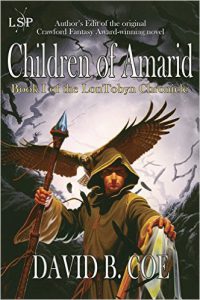 I did just that. I started with some short stories that have never since seen the light of day, but which helped me to shape the contours of my world and its history. Then I began work on the novel, and by September had completed the first five chapters of what would eventually be Children of Amarid, my first published novel. I gave the manuscript to a friend of the family who had been a publisher, and he agreed to act as my agent, operating under standard agenting fees. He sent those five chapters and an outline of the rest of the book to various fantasy publishers.
I did just that. I started with some short stories that have never since seen the light of day, but which helped me to shape the contours of my world and its history. Then I began work on the novel, and by September had completed the first five chapters of what would eventually be Children of Amarid, my first published novel. I gave the manuscript to a friend of the family who had been a publisher, and he agreed to act as my agent, operating under standard agenting fees. He sent those five chapters and an outline of the rest of the book to various fantasy publishers.